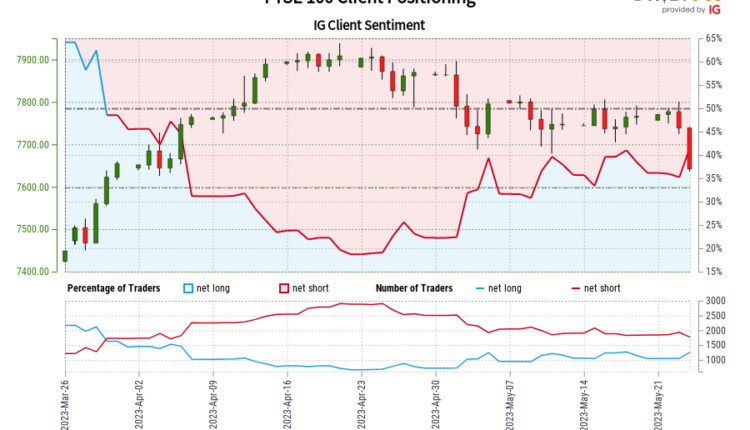Our data shows traders are now net-long FTSE 100 for the first time since Mar 30, 2023 when FTSE 100 traded near 7,622.50.

Number of traders net-short has decreased by 14.44% from last week.
| SYMBOL | TRADING BIAS | NET-LONG% | NET-SHORT% | CHANGE IN LONGS | CHANGE IN SHORTS | CHANGE IN OI |
|---|---|---|---|---|---|---|
| FTSE 100 | BEARISH | 50.18% | 49.82% |
34.98% Daily 28.14% Weekly |
-13.68% Daily -14.44% Weekly |
5.38% Daily 2.68% Weekly |
| Change in | Longs | Shorts | OI |
| Daily | 35% | -14% | 5% |
| Weekly | 28% | -14% | 3% |
FTSE 100: Retail trader data shows 50.18% of traders are net-long with the ratio of traders long to short at 1.01 to 1. In fact, traders have remained net-long since Mar 30 when FTSE 100 traded near 7,622.50, price has moved 0.26% higher since then. The number of traders net-long is 34.98% higher than yesterday and 28.14% higher from last week, while the number of traders net-short is 13.68% lower than yesterday and 14.44% lower from last week.
We typically take a contrarian view to crowd sentiment, and the fact traders are net-long suggests FTSE 100 prices may continue to fall.
Our data shows traders are now net-long FTSE 100 for the first time since Mar 30, 2023 when FTSE 100 traded near 7,622.50. Traders are further net-long than yesterday and last week, and the combination of current sentiment and recent changes gives us a stronger FTSE 100-bearish contrarian trading bias.


Comments are closed.